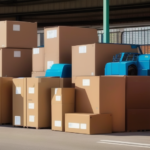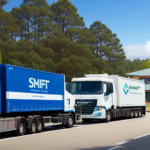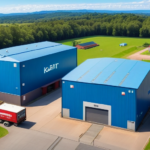Introduction to Georgia-Pacific and Smurfit Kappa
In the highly competitive packaging industry, Georgia-Pacific and Smurfit Kappa stand out as leading companies renowned for their high-quality products and innovative solutions. Both organizations play pivotal roles in the global packaging sector, continually pushing the boundaries of sustainability and efficiency.
Company Overview
Georgia-Pacific
Georgia-Pacific, headquartered in Atlanta, Georgia, is a privately-owned company that manufactures and markets a diverse range of paper and packaging products. With over 30 facilities worldwide and a workforce exceeding 30,000 employees, Georgia-Pacific serves various industries, including consumer goods, industrial products, and building materials.
Smurfit Kappa
Smurfit Kappa is a publicly-traded company based in Dublin, Ireland, with operations in more than 30 countries and approximately 46,000 employees. The company specializes in paper-based packaging solutions tailored to sectors such as food and beverage, agriculture, and consumer goods. Smurfit Kappa is committed to sustainability, aiming for complete sustainability by 2030 through responsible sourcing and carbon footprint reduction initiatives.
Product Offerings
Georgia-Pacific Products
Georgia-Pacific offers a wide array of paper and packaging products, including:
- Bathroom tissue and napkins
- Disposable tableware
- Corrugated boxes for retail and industrial markets
- Specialty papers and pulp products
Smurfit Kappa Products
Smurfit Kappa specializes in innovative paper-based packaging solutions, such as:
- Corrugated boxes and containers
- Bags and flexible packaging
- Customized packaging solutions for specific industries
- Eco-friendly and recyclable packaging options
Market Analysis
Market Share
Together, Georgia-Pacific and Smurfit Kappa hold an estimated 10% share of the global packaging market. Their dominance is fueled by continuous innovation, strategic acquisitions, and a strong commitment to sustainability. According to Statista, the global packaging market is projected to reach over $1 trillion by 2025, indicating significant growth opportunities.
Key Competitors
Major competitors in the packaging industry alongside Georgia-Pacific and Smurfit Kappa include:
- International Paper: A leader in packaging, pulp, and paper products.
- WestRock: Known for its extensive international presence and corrugated packaging solutions.
- DS Smith: Specializes in sustainable packaging and supply chain solutions.
- Pratt Industries: Focuses on environmentally friendly packaging and paper products.
- Mondi Group: Produces a wide range of packaging and paper products globally.
Emerging competitors like Packlane and Loop Industries are disrupting the market with customizable and sustainable packaging solutions, respectively.
Financial Performance
Georgia-Pacific
As a privately-owned entity, Georgia-Pacific does not publicly disclose detailed financial information. However, the company continues to invest strategically in its operations, including a notable $100 million investment in its Alabama River Cellulose mill in 2019 to enhance production capacity and sustainability efforts.
Smurfit Kappa
Smurfit Kappa, being publicly traded, provides transparent financial disclosures. According to its 2023 annual report, Smurfit Kappa generated €10.2 billion in revenue, reflecting an 8% growth from the previous year. This growth is attributed to strategic acquisitions, expansion into new markets, and a strong emphasis on sustainable practices.
Georgia-Pacific’s ongoing investments in sustainability and capacity expansion contribute to its long-term financial stability, positioning the company for continued success despite the challenges of being a private entity.
Growth Strategies: Mergers and Acquisitions
Smurfit Kappa
Smurfit Kappa has actively pursued mergers and acquisitions to drive growth and expand its market presence. Notable acquisitions include:
- Reparenco in 2018, enhancing its footprint in the Benelux region.
- Orange County Container Group (OCCG) in 2012, significantly expanding its operations on the U.S. West Coast.
Georgia-Pacific
Georgia-Pacific has also strategically acquired companies to broaden its product offerings and market reach. Key acquisitions include:
- Buckeye Technologies in 2013, strengthening its specialty fibers business.
- SPG Holdings in 2018, expanding its presence in the European tissue market.
These acquisitions have not only increased production capacity but also enhanced the companies' abilities to meet diverse customer needs globally.
SWOT Analysis
Strengths
- Global presence and strong brand reputation.
- Leadership in innovation and product development.
- Highly skilled and dedicated workforce.
- Diverse range of products catering to various industries.
Weaknesses
- Georgia-Pacific’s private status limits financial transparency.
- Smurfit Kappa’s significant reliance on the European market may pose vulnerabilities.
Opportunities
- Growth of the e-commerce industry increasing demand for packaging materials.
- Expanding into emerging markets through strategic acquisitions and partnerships.
- Development of innovative and sustainable packaging solutions.
Threats
- Supply chain disruptions caused by global events like pandemics.
- Volatility in raw material prices affecting production costs.
- Intensifying competition from both established and emerging players.
- Increasing regulatory pressures related to environmental sustainability.
Industry Trends
The packaging industry is undergoing significant transformations driven by several key trends:
- Sustainable Packaging: A surge in demand for eco-friendly packaging solutions to minimize environmental impact. Companies are investing in recycled materials and innovative designs to meet consumer expectations.
- Circular Economy: Emphasis on using renewable and recycled materials to create sustainable packaging. This approach reduces waste and promotes recycling and reuse within the supply chain.
- Technological Innovation: Adoption of advanced technologies such as automation, artificial intelligence, and smart packaging to enhance efficiency and customize solutions.
- Consumer Preferences: Growing consumer awareness and preference for sustainable and ethically produced packaging influencing company strategies.
Both Georgia-Pacific and Smurfit Kappa are actively aligning their operations with these trends by investing in sustainable production methods and leveraging recycled materials, ensuring they remain competitive and meet evolving market demands.
Challenges in the Packaging Industry
Despite their strong market positions, Georgia-Pacific and Smurfit Kappa face several challenges:
- Supply Chain Disruptions: Events such as the COVID-19 pandemic have caused significant disruptions and price fluctuations, impacting production schedules and costs.
- Raw Material Price Volatility: Fluctuating costs of raw materials like paper pulp can affect profitability and operational efficiency.
- Environmental Concerns: Increasing pressure to adopt sustainable practices and reduce the environmental footprint requires continuous innovation and investment.
- Rising Competition: Emerging competitors introducing innovative and sustainable packaging solutions intensify market competition.
Both companies leverage their strong financial performance and commitment to innovation to navigate these challenges effectively, ensuring resilience and adaptability in a dynamic market landscape.
Conclusion: Future Outlook for Georgia-Pacific and Smurfit Kappa
Georgia-Pacific and Smurfit Kappa have established themselves as dominant forces in the global packaging industry through their innovative products, strategic growth initiatives, and unwavering commitment to sustainability. As the industry continues to evolve with emerging trends and shifting consumer demands, both companies are well-positioned to maintain their leadership positions.
By focusing on sustainable practices, expanding through strategic acquisitions, and embracing technological advancements, Georgia-Pacific and Smurfit Kappa are poised for continued success and growth in the packaging sector for years to come.






















